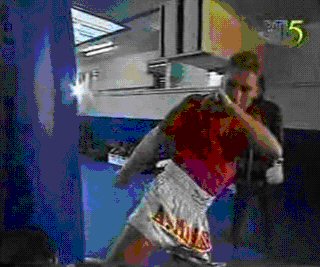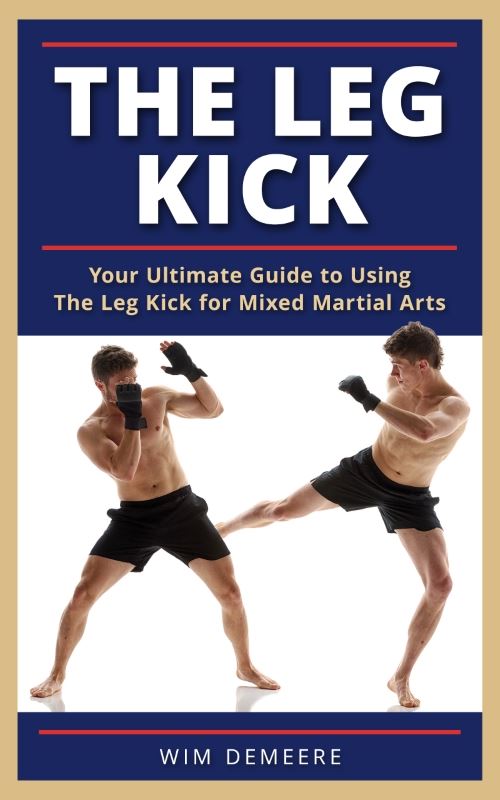UPDATE: The Leg Kick: Your Ultimate Guide to Using The Leg Kick for Mixed Martial Arts is now available! Click the link to get the book or click this picture:
Here’s Part Two of “How to do a leg kick.” It’s a bit more than I first planned on doing so I’m only covering the use of the lead arm. Otherwise this post would get way too big to read comfortably. I’ll talk about the rear arm in Part Three. Here we go:
The lead arm
There are a bunch of factors involved here and, in my opinion, things aren’t black or white. You can move the lead arm in a number of ways with each one having specific strengths and weaknesses. If you learned a certain way or have to do it because it’s “traditional”, that’s fine. As I stated in the first part, pick what you like from this guide and ignore the rest.
Keep the lead arm high and to the side.
- As you kick, pull the arm in and try to keep the elbow close to your ribs. Keep your hand close to the lead side of your face as well, for obvious reasons.
- This arm position has the advantage of protecting the lead side of the face and body. If your opponent counters with a hook or round kick to he body on that side, you have at least some protection there.
- It’s also the easiest way to hold your lead arm. You’ll notice it doesn’t take much effort and comes naturally.
- The key advantage is that you can punch with the lead hand much more comfortably right after your leg kick returns. The hand is in it’s usual place so you don’t have to follow a different path to whichever punch you throw next.
- The downside is that the arm tends to flail. Even if you focus on keeping it tight, once you start kicking with power your arm will tend to move around a bit. That automatically creates an opening for your opponent.
- Even if you do it right, there is an opening for straight punch counters by your opponent. You can minimize that threat by tucking in your chin and bringing the rear shoulder against it. But that still leaves the top of your head and temple area open.
- How do you avoid these counters? Try setting up the leg kick correctly (we’ll cover that in a later part.) or kick the opponent when he cannot easily attack you through those openings.
Take a look at this clip:
In almost every leg kick Kaman makes, he keeps the lead arm high and on his left side. He delivers two rear leg kicks in the first 30 seconds. The first one lands after redirecting Robinson’s kick. Robinson is off balance and can’t counter so Kaman fires a leg kick. His lead hand is high and he is perfectly safe from counters.
The same thing happens at 40 sec. Kaman puts Robinson’s weight on his lead leg with the hook and steps a little to the side at the same time. This ensures Robinson can’t easily block the leg kick because he first needs to get his weight off his lead leg. It also drives him to Kaman’s right while Rob steps slightly to the left. This moves Robinson’s weapons away from Kaman’s left side and takes away the danger of counters.
You’ll notice the same thing happening several times in this clip. It’s only near the end of the fight, when Robinson is clearly afraid of the leg kicks, that Kaman changes tactics a bit and just fires the kick at will.
BTW, Rob makes one really bad leg kick in this fight. See if you can spot it; we’ll cover why in another part.
Bring the hand across the body.
- The next option is to bring your lead hand across your body. If you go all the way across you can cover the opposite side of your face. This protects you against the straight punch which is a common counter against the leg kick. Take a look at this :

- Point your palm out like in this picture and you can “catch” a straight counter punch to the head, especially if you’re wearing gloves.
- Another way is to tuck your chin in to minimize the opening to your face as your hand comes to covers. This double protection can absorb a part of the impact of that same counter.
- Another benefit is that the crossing movement helps in stabilizing your body as you turn your hips into the kick
It’s not either or though; both arm positions are on opposite ends of the scale and there are many possibilities in between. So don’t focus on just these two positions but see what happens when you hold the lead hand between them. It could turn out to work better for you that way.
Here’s what I mean:
At 1.50min, Buakaw throws several leg kicks. He brings his lead hand across the body but not all the way to the opposite side of his face. In fact, sometimes his hand stays dangerously low, leaving his face totally open. But then Takayama isn’t really in a position to do much about it so the point is moot. Just notice the direction his lead arm moves in; across the body. Even if it isn’t in the ideal place to cover his face, it is at least moving in the right direction.
At this point you might be figuring “Why go on so much about the arm position? It’s the impact of the kick that counts!” and you’d be right. Your priority is always to make sure whatever technique you fire ends up landing with maximum impact. But your first priority should be to avoid taking any damage. Because as soon as you do, it becomes harder to throw your next technique. Take enough damage and you can’t even attack anymore and you end up being beaten to a bloody pulp.
A great fighter thinks about defense as he is going on the offense. There’s no need to switch form one to the other; just do both to the best of your abilities.
That’s it for part Two. Part Three is about the rear arm and what it should or could be doing.



markstraining.com says
For me, I always prefer keeping the hands in front of the face when performing leg kicks. Although people claim to generate more power by swinging one arm back behind them, I think its the turning of the hips and hitting at the correct spot with the correct part of the shin that makes the kick powerful. good article.
markstraining.com says
For me, I always prefer keeping the hands in front of the face when performing leg kicks. Although people claim to generate more power by swinging one arm back behind them, I think its the turning of the hips and hitting at the correct spot with the correct part of the shin that makes the kick powerful. good article.
Wim says
That’s also a good option. The whole thing I’m trying to get across with this guide is tha tthere’s no one way of doing the technique. Pretty much the same with every technique but I digress.. :-)
Thanks for the feedback,
Wim
Sean @ Gisoku Budo says
Thanks for the follow-up on this one – will definitely have to make some time to have ago at it with all the tips in mind, as I don’t really know what the hell I’m doing when I try this kind of kick :)
Sean @ Gisoku Budo says
Thanks for the follow-up on this one – will definitely have to make some time to have ago at it with all the tips in mind, as I don’t really know what the hell I’m doing when I try this kind of kick :)
Wim says
In your case it’ll probably depend on which leg you use to kick with. I’m guessing the first movement, getting your momentum going might be the hardest. Perhaps a drop step? Dunno, just theorizing here.
BelfasKalista says
This is my backyard. 2 things I would say, at first:
(1) Train the kick lazily and heavily.
(2) Do guard drill to learn how to cover the upper half. Not much point in landing a great kick if the other guy punches you in the face at the same time and you both end up on your arses.